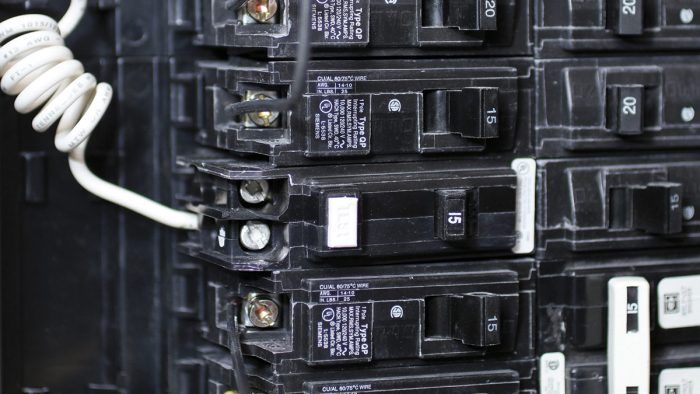How To Install A Afci Circuit Breaker
Fine Homebuilding Projection Guides
Wiring
How-To
Installing an AFCI Billow
Here's how (and why) to install protective AFCI breakers, which are wired somewhat differently from conventional breakers.

Installing a one-pole, xv-amp AFCI (arc-fault-circuit-interrupter) breaker is exactly the same every bit installing a one-pole GFCI (ground-fault-circuit-interrupter) breaker. But before we run across how to install 1, here is a quick refresher about how each of these lawmaking-required devices protects y'all.
AFCI breakers are designed to detect arcing patterns of current in very brusque time intervals—such as when there is a loose connectedness on a receptacle and electricity arcs (jumps) between conductors. Drywall nails or screws puncturing a cable are other common causes of arc faults. When an AFCI billow detects such patterns, information technology shuts off power to protect you from business firm fires.
GFCI breakers are designed to sense an imbalance betwixt the amount of current flowing from the hot wire and returning on the neutral wire, which suggests a ground-error current is leaking to basis somewhere. GFCIs tin discover minuscule (5 milliamp) current leaks and shut off power virtually instantaneously—typically inside one⁄40 second—to protect people from potentially fatal shocks.
Always turn off ability to a panel and test to be sure it'southward off. After pulling the new circuit cablevision into the subpanel, the electrician secured information technology with a cable connector and stripped its sheathing, as described above. As is customary, he first terminated the cablevision's bare ground wire to the ground motorcoach.
Every AFCI (and every GFCI) breaker has a coiled neutral conductor that is molded into the billow at the mill. After snapping the AFCI breaker onto a hot bus, the electrician attached that coiled neutral to the neutral bus 1. The electrician then stripped three⁄8 in. to 1⁄ii in. of insulation from the terminate of the circuit-cable neutral and terminated it to the AFCI breaker lug, designated past a minor white dot next to information technology 2. Annotation: Almost circuit neutral wires terminate to a neutral jitney. But hither the excursion neutral attaches to the billow so it can sense fluctuations in current throughout the excursion.


Finally, the electrician stripped insulation from the end of the excursion hot wire and attached information technology to the remaining breaker lug three. He used a multimeter to test for a dead short in the circuit. Finding nix out of the ordinary, he removed a breaker knockout from the subpanel encompass, replaced the encompass, and energized the subpanel. Then he flipped the AFCI breaker on and pressed the white Exam push button on the face of the breaker. The TEST button should snap off immediately; if it doesn't, the breaker is probably defective and should be replaced immediately. Inspectors are very serious nigh AFCI protection, so always test AFCI breakers after installing them—even if they are right out of the box.

Ii-Pole AFCI Breakers
Since the 2008 NEC, AFCI protection is required for co-operative circuits in all areas inside the house except bathrooms, kitchen, garage, and unfinished basements and attics.
AFCI breakers are wired somewhat differently from conventional breakers, with an integral coiled neutral attaching to the neutral passenger vehicle and the circuit neutral attaching to an AFCI billow neutral lug. The circuit hot then attaches to the AFCI breaker hot lug.
This configuration allows an AFCI billow to monitor current flow throughout the circuit, but it sometimes leads to problems when nonclerical installers utilise 3-wire cable to serve 2 circuits—i of which must be AFCI-protected and the other is not. Their mistaken solution is to attach ane hot wire of the 3-wire cable to an AFCI breaker and the other hot to a regular (not-AFCI) breaker. They then notice that the AFCI breaker doesn't work—it keeps flipping off.
The solution: If y'all want to use 3-wire cablevision to provide AFCI protection to at least one of the circuits, you lot must install a 2-pole AFCI breaker and attach both hot wires to information technology. The cable's neutral attaches to the breaker's neutral lug, as described to a higher place. In this manner, the AFCI can monitor current menses in both circuits.


Excerpted from Wiring Complete, 3rd Edition (The Taunton Press, 2022) by Michael Litchfield and Michael McAlister
Available in the Taunton Store and at Amazon.com.
Previous: Ground-Fault Circuit Interrupters (GFCIs) Next: How to Install an Arc-Fault Breaker
Source: https://www.finehomebuilding.com/project-guides/wiring/installing-an-afci-breaker
Posted by: phillipsharfidut.blogspot.com


0 Response to "How To Install A Afci Circuit Breaker"
Post a Comment